BLOG
How to Mitigate the Financial Impact of Tier 4 Regulations

In 2015, American heavy equipment companies will be subject to the many pressures associated with the purchase and use of Tier 4 equipment. Tier regulations require manufacturers to adhere to emissions regulations in the production of equipment engines. The EPA introduced Tier 4 in 2004 and designated a ramp-up period from 2008-2015 so that manufacturers could phase-in engine design changes that would meet the stringent standards. Well, 2015 is here, and manufacturers will not be the only ones impacted by the new requirements. Their burden is already being passed on to the companies that use heavy equipment in the form of higher acquisition costs.
How Tier 4 Impacts Your Heavy Equipment Business
Selling Equipment With Remaining Utility
Most businesses that utilize diesel driven equipment to conduct their business operations adhere to a predictable schedule of disposition and acquisition of their company’s equipment. Tier 4 mandates now require many companies to sell off used equipment far short of the end of its utility and useful life. This has cost ramifications.
Sacrificing Government Contracts
Many companies that depend on federal and state contracts will not be able to bid on or work jobs if their equipment is not Tier 4-compliant — once again imposing extra costs onto businesses who are forced to upgrade equipment if they want to work on government projects. These companies will have to upgrade to equipment that is Tier 4-compliant if they want this business.
Increased Maintenance Cost
If companies do not replace their fleets with Tier 4 approved equipment, they will not only find themselves at a competitive disadvantage; they will see their maintenance costs on non-compliant equipment rise as the use of that equipment is increasingly disincented.
Consider a 1031 Like-Kind Exchange Strategy
Given these challenges, companies may consider a 1031 like-kind exchange strategy as part of their equipment acquisition/disposition practice. Such a strategy could provide owners the cash flow boost necessary to mitigate the new equipment-replacement policies that come with Tier 4.
Section 1031 of the IRC Tax Code provides for the deferral of taxes on realized gains from the sale of business assets. This can result in an immediate cash benefit of 40% of the sale revenues generated when you dispose of your old or non-compliant equipment, money that would otherwise be paid in taxes.
If you bought a piece of construction equipment for $200,000, used it in your business for five years, and then sold it for $50,000, you would normally owe $20,000 in income taxes — leaving you with only $30,000 to buy new equipment. With a 1031 like-kind exchange, you would pay ZERO in taxes and have the entire $50,000 to use towards purchasing new equipment.
Conclusion
A company’s success is intrinsically linked to its ability to replace and replenish its business equipment in a timely and financially-viable manner. Embracing a personal property like-kind exchange strategy may be an advantageous means of generating extra cash for the purchase of new equipment to stay competitive in a Tier 4 environment.
